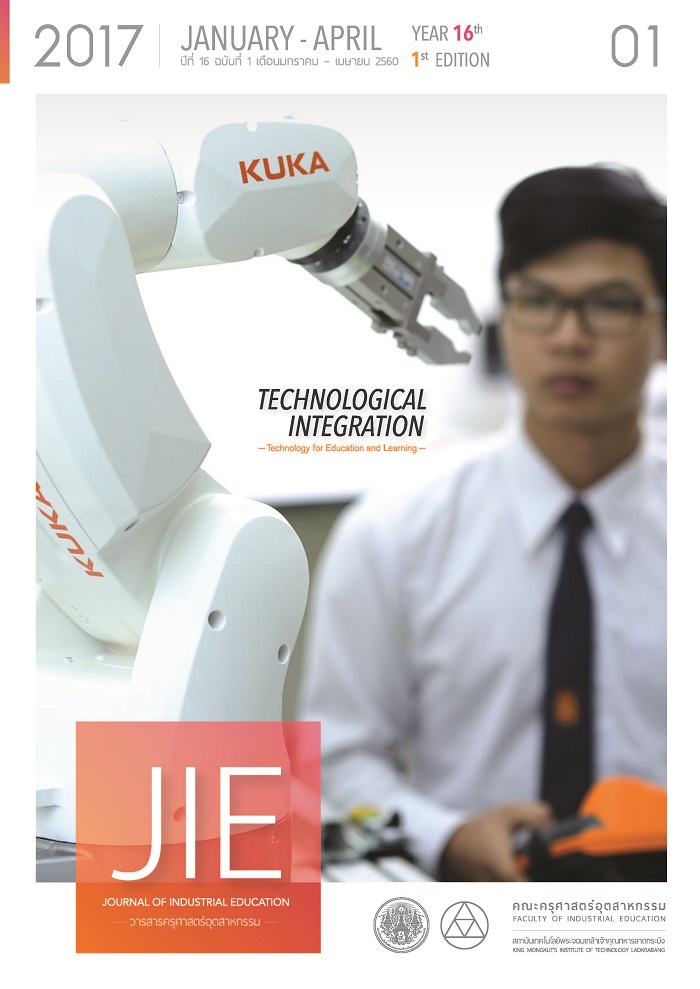THE DEVELOPMENT OF INDUCTIVE LEARNING ACTIVITIES PACKAGE WITH GROUP PROCESS ON CALCULUS 2 FOR UNDERGRADUATE STUDENT
Keywords:
Learning Activities Package, Inductive, Group Process, Mathematics, LearningAbstract
The purpose of this research were: 1) to develop and effectiveness of Inductive Learning Activities With Group Processes On Calculus 2 for Undergraduate Student, 2) to study learning achievement after learning by Inductive Learning Activities With Group Processes On Calculus 2 for Undergraduate Student with criteria, 3) to study behavior’s group working by learning with Inductive Learning Activities With Group Processes, and The population consisted of 23 undergraduates who enrolled Calculus 2 in the second semester of the academic year 2015. The instruments in this research are: 1) Inductive Learning Activities With Group Processes On Calculus 2 for Undergraduate Student, 2) the quality assessment form for Inductive Learning Activities With Group Processes 3) Learning Achievement Test. The data were analyzed by frequency, percentage, mean, standard deviations and t-test. The results of this research were :1) The Inductive Learning Activities With Group Processes on the topic Derivative efficiency is 76.62/79.90, 2) The learning achievement after using Inductive Learning Activities with Group Processes pass the criteria , 3) behavior’s Group working is good level
References
[2] An Educational Reformation Committee. Office of Academic, Ministry of Education. 2001. The Research Synthesis of Students’Center. Bangkok : The teacher council of Thailand..
[3] Rotnukoonwanit, S. 2005. An Inductive Method Instruction Module by Group Process in Secondary School Students Grade 9: Possibility. Master of Education Thesis in Secondary Educaiton, Srinakharinwirot University.
[4] James B. S., 1998. The Effects of Diversity on Small Work Group Processes and Performance. Sage Journal, Retrieved June 20 2016.Available from: http :// hum.sagepub.com.
[5] Yoochomboon, B. 1986. The Behavior of Teaching and Studying Mathematics in Primary Schools. Bangkok: Odeon Store.
[6] MoonKham, S & MoonKham,O. 2005. Learning Management for Thinking Process Development. Bangkok: Parbpim. (in Thai)
[7] Dechakupt, P. 2001. Teaching as a Student’s Centre: Concept, Methods, and Teaching Techniques 1. Bangkok : The Mastergroup Management.
[8] Sawekvi, U. 2008. Ness’s Model on Integrated Teaching Method. A research, Department of Mathematics, Rajamangala University of Technology Thanyaburi.
[9] Phromwong, C. 2008. An Instructional Module. Retrieved from http://www.innowake.blogspot.com.
[10] Khuanharwet, B. 1999. Educational Innovation. 4th Ed. Bangkok: Charenwit Printing.
[11] Saiyot, L & Saiyot, A. 2001. Research Techniques for Education. 4th Ed. Bangkok: Suviriyasarn.
[12] Aunaromlert, T. 2006. Research Tools for Education: Innovation and Development. Nakorn Pathom: Faculty of Education, Silpakorn University.
[13] Wongyai, W. 1982. The New Dimension of Teaching Development. 3rd Ed. Bangkok: Thanet Printing.
[14] Suwannarong, S, Sukkamart, A & Pimdee, P. 2015. The Development of Instructional Package for Reinforce The system Thinking with Cooperative and Problem Based Learning for Mathayomsuksa 5 at Badindecha ( Sing Singhaseni) School. Journal of Industrial Education. Vol.(14)3. p.7784
[15] Srisa-ard, B. 1998. Teaching Development. 2nd Ed. Bangkok: Chomromdek.
[16] Pipitku, Y. 2003. Teaching and Studying Mathematics: Educational Reformation. Bangkok: Borpit Printing.
[17] Chuesuwantawee, C. 2001. Teaching Mathematics. Bangkok: Department of Curriculum and Instruction. Faculty of Education, Srinakharinwirot University.
[18] Muenthaisong, S. 2010. A Use of Cooperating Learning Techniques with Inductive Method towards Secondary School Students Grade 7’s Mathematics Learning Achievement and Attitude: Power. Master of Education Thesis in Curriculum and Instruction, Mahasarakham University.
[19] Duwao, W. 2011. A Learning Outcomes of Primary School Students grade 5 by Inductive Method in Mathematics subject: Multiplication and Division of the Fraction. Master of Education Thesis in Curriculum and Instruction, Chiangrai Rajabhat University.
[20] Wongwit, J. 2013. A Study of Learning Outcomes of Teaching Mathematics for Primary School Students Grade 6: Addition, Subtraction, Multiplication, and Division of the Fraction. Master of Education Thesis in Curriculum and Instruction, Chiangrai Rajabhat University.
[21] Nihad , M. 2005. Inductive Reasoning in The Algebra Classroom. Faculty of the Department of Mathematics. San Jose State University. [22] Office of the National Education. 1997. Educational Assurance System and National Educational Standard. Bangkok : The teacher council of Thailand.
[23] Chaimongkol, J. 2007. The Behavior Adjustment in the Mathematics Classroom by Groupwork, Secondary School Student Grade 1 at Mae Tuen Wittaya. Master of Education Thesis, Mahasarakham University.
[24] Soommart, C. 2008. A Study of the Use of Group Process for Teaching Science for Primary School Students Grade 3. Master of Education Thesis in Curriculum and Instruction, Nakorn Ratchasima Rajabhat University.
Downloads
Published
How to Cite
Issue
Section
License
"The opinions and contents including the words in papers are responsibility by the authors."
"ข้อคิดเห็น เนื้อหา รวมทั้งการใช้ภาษาในบทความถือเป็นความรับผิดชอบของผู้เขียน"



